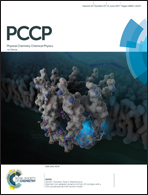Collision-induced dissociation of sodiated glucose and identification of anomeric configuration†
Abstract
Collision-induced dissociation (CID) of sodiated glucose was investigated using electronic structure calculations and resonance excitation in a low-pressure linear ion trap. The major dissociation channels in addition to desodiation are dehydration and C2H4O2 elimination reactions which the barrier heights are near to or lower than the sodiation energy of glucose. Dehydration reaction involves the transfer of the H atom from the O2 atom to the O1 atom, followed by the cleavage of the C1–O1 bond. Notably, α-glucose has a dehydration barrier lower than that of β-glucose. This difference results in the larger branching ratio of dehydration reactions involving α-glucose, which provides a simple and fast method for identifying the anomeric configurations of glucose. The C2H4O2 elimination starts from the H atom transfer from the O1 atom to the O0 atom, followed by the cleavage of the C1–O0 bond. These results were further confirmed by experimental study using 18O-isotope-labeled compounds. Both the experimental data and theoretical calculations suggest that the dehydration reaction and cross-ring dissociation of sodiated carbohydrates mainly occur at the reducing end during low-energy CID.



 Please wait while we load your content...
Please wait while we load your content...